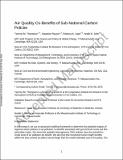| dc.contributor.author | Thompson, Tammy M | |
| dc.contributor.author | Rausch, Sebastian | |
| dc.contributor.author | Saari, Rebecca K | |
| dc.contributor.author | Selin, Noelle E | |
| dc.date.accessioned | 2025-04-29T20:09:05Z | |
| dc.date.available | 2025-04-29T20:09:05Z | |
| dc.date.issued | 2016-05-24 | |
| dc.identifier.uri | https://hdl.handle.net/1721.1/159215 | |
| dc.description.abstract | To mitigate climate change, governments ranging from city to multi-national have adopted greenhouse gas (GHG) emissions reduction targets. While the location of GHG reductions does not affect their climate benefits, it can impact human health benefits associated with co-emitted pollutants. Here, an advanced modeling framework is used to explore how subnational level GHG targets influence air pollutant co-benefits from ground level ozone and fine particulate matter. Two carbon policy scenarios are analyzed, each reducing the same total amount of GHG emissions in the Northeast US: an economy-wide Cap and Trade (CAT) program reducing emissions from all sectors of the economy, and a Clean Energy Standard (CES) reducing emissions from the electricity sector only. Results suggest that a regional CES policy will cost about 10 times more than a CAT policy. Despite having the same regional targets in the Northeast, carbon leakage to non-capped regions varies between policies. Consequently, a regional CAT policy will result in national carbon reductions that are over six times greater than the carbon reduced by the CES in 2030. Monetized regional human health benefits of the CAT and CES policies are 844% and 185% of the costs of each policy, respectively. Benefits for both policies are thus estimated to exceed their costs in the Northeast US. The estimated value of human health co-benefits associated with air pollution reductions for the CES scenario is two times that of the CAT scenario. Implications: In this research, an advanced modeling framework is used to determine the potential impacts of regional carbon policies on air pollution co-benefits associated with ground level ozone and fine particulate matter. Study results show that spatially heterogeneous GHG policies have the potential to create areas of air pollution dis-benefit. It is also shown that monetized human health benefits within the area covered by policy may be larger than the model estimated cost of the policy. These findings are of particular interest both as U.S. states work to develop plans to meet state-level carbon emissions reduction targets set by the EPA through the Clean Power Plan, and in the absence of comprehensive national carbon policy. | en_US |
| dc.language.iso | en | |
| dc.publisher | Informa UK Limited | en_US |
| dc.relation.isversionof | 10.1080/10962247.2016.1192071 | en_US |
| dc.rights | Creative Commons Attribution-Noncommercial-ShareAlike | en_US |
| dc.rights.uri | http://creativecommons.org/licenses/by-nc-sa/4.0/ | en_US |
| dc.source | University of Waterloo | en_US |
| dc.title | Air quality co-benefits of subnational carbon policies | en_US |
| dc.type | Article | en_US |
| dc.identifier.citation | Thompson, T. M., Rausch, S., Saari, R. K., & Selin, N. E. (2016). Air quality co-benefits of subnational carbon policies. Journal of the Air & Waste Management Association, 66(10), 988–1002. | en_US |
| dc.contributor.department | Massachusetts Institute of Technology. Joint Program on the Science & Policy of Global Change | en_US |
| dc.contributor.department | Massachusetts Institute of Technology. Department of Earth, Atmospheric, and Planetary Sciences | en_US |
| dc.contributor.department | MIT Institute for Data, Systems, and Society | en_US |
| dc.relation.journal | Journal of the Air & Waste Management Association | en_US |
| dc.eprint.version | Author's final manuscript | en_US |
| dc.type.uri | http://purl.org/eprint/type/JournalArticle | en_US |
| eprint.status | http://purl.org/eprint/status/PeerReviewed | en_US |
| dc.date.updated | 2025-04-29T20:01:25Z | |
| dspace.orderedauthors | Thompson, TM; Rausch, S; Saari, RK; Selin, NE | en_US |
| dspace.date.submission | 2025-04-29T20:01:26Z | |
| mit.journal.volume | 66 | en_US |
| mit.journal.issue | 10 | en_US |
| mit.license | OPEN_ACCESS_POLICY | |
| mit.metadata.status | Authority Work and Publication Information Needed | en_US |
